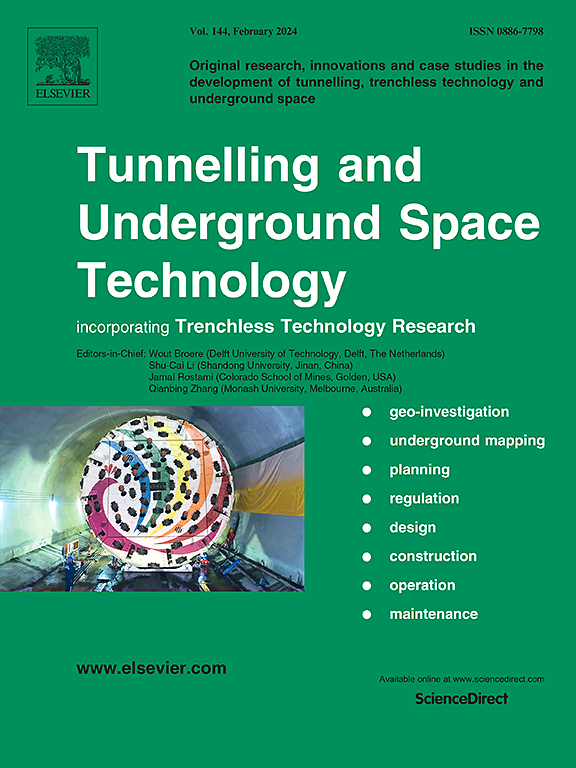砂土中双能量隧道的热交换与热相互作用
IF 7.4
1区 工程技术
Q1 CONSTRUCTION & BUILDING TECHNOLOGY
引用次数: 0
摘要
近年来,能源隧道作为城市环境中供热和制冷需求的可持续解决方案受到了广泛关注。同时,随着对地下空间需求的不断增加,为了优化空间利用和容纳密集的城市基础设施,往往采用双隧道结构。为此,本文对双能隧道同步运行的热性能进行了研究。基于都灵地铁1号线现场试验验证的方法,建立了地下水流速、地下水位和清距对埋沙双能量隧道热交换率和热相互作用的影响的数值模型。结果表明:当隧道完全淹没于地下水位以下时,上游隧道产生的热羽流降低了下游隧道的换热效率;随着地下水流速的增加,这种下降的效率继续增加,达到0.5 m/d。超过这个速度,热补给的增长影响变得更加显著,降低了一个隧道对另一个隧道的热羽效应。同时,净距越小,热相互作用越大,下游隧道效率越低。此外,最佳清净距离显著依赖于地下水流速。当地下水位处于或低于隧道仰拱时,上游隧道热羽流的影响不明显。研究发现,这两条隧道的性能在三年的热作业中保持一致,这是由于地下水流动和充足的回收期。本文章由计算机程序翻译,如有差异,请以英文原文为准。
Heat exchange and thermal interactions of twin energy tunnels in sand
In recent years, energy tunnels have gained significant attention as sustainable solution for heating and cooling demands in urban environments. Meanwhile, with the increasing demand for underground space, twin tunnel configurations are often adopted to optimize space utilization and accommodate dense city infrastructures. Therefore, this paper investigates the thermal performance of twin energy tunnels operating simultaneously. A numerical model, based on an approach validated against field test results of Turin Metro line 1, was developed to study the influence of groundwater flow velocity, groundwater level, and clear distance on heat exchange rates and thermal interactions of twin energy tunnels embedded in sand. The results show that when tunnels are fully submerged under the ground water table, the thermal plumes induced by the upstream tunnel decrease the heat exchange efficiency of the downstream tunnel. This decreasing efficiency continues to increase with increasing groundwater flow velocity up to 0.5 m/d. Beyond this velocity, the growing influence of thermal recharge becomes more significant, reducing the thermal plumes effect of one tunnel to the other. At the same time, a smaller clear distance results in higher thermal interactions and consequently lower efficiency of the downstream tunnel. Additionally, the optimal clear distance was observed to significantly depend on groundwater flow velocity. The influence of thermal plumes of the upstream tunnel become less significant when the groundwater level at or below the tunnel invert. The performance of both tunnels was found to remain consistent over three years of thermal operations, and this is attributed to groundwater flow and sufficient recovery periods.
求助全文
通过发布文献求助,成功后即可免费获取论文全文。
去求助
来源期刊

Tunnelling and Underground Space Technology
工程技术-工程:土木
CiteScore
11.90
自引率
18.80%
发文量
454
审稿时长
10.8 months
期刊介绍:
Tunnelling and Underground Space Technology is an international journal which publishes authoritative articles encompassing the development of innovative uses of underground space and the results of high quality research into improved, more cost-effective techniques for the planning, geo-investigation, design, construction, operation and maintenance of underground and earth-sheltered structures. The journal provides an effective vehicle for the improved worldwide exchange of information on developments in underground technology - and the experience gained from its use - and is strongly committed to publishing papers on the interdisciplinary aspects of creating, planning, and regulating underground space.
 求助内容:
求助内容: 应助结果提醒方式:
应助结果提醒方式:


